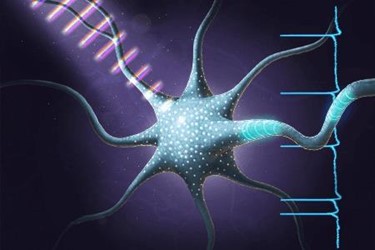Ultrafast Pulses Modulate Circadian Rhythm And Blues
By Jof Enriquez,
Follow me on Twitter @jofenriq

Manipulating the spectral components of ultrafast, near-infrared pulses of light can influence neural activity, paving the way for more effective treatments of mood and circadian rhythm sleep disorders, according to a team of researchers at the University of Illinois.
Scientists in the field of optogenetics – a field in neuroscience exploring the use of light to control or measure the behavior of neurons – have successfully been using light-sensitive proteins, called opsins, to control cell functions. Typically, opsins are genetically engineered to improve cell activation at a specific wavelength, or to make the protein predominantly absorb a different color of light.
However, parameters governing nonlinear light properties, such as phase and amplitude of an ultrashort light pulse, are seldom tweaked to stimulate cells. This method, called coherent control, has been used in chemical reactions, but researchers at the University of Illinois are the first to apply it to control function in a living cell.
In a demonstration, the team used very short light pulses, each less than 100 femtoseconds in duration, as well as varying wavelengths, to excite light-sensitive channels in the membrane of neurons, causing them to fire.
“When you have an ultrashort or ultrafast pulse of light, there’s many colors in that pulse. We can control which colors come first and how bright each color will be,” said Dr. Stephen Boppart, who is professor of electrical and computer engineering and of bioengineering at the University of Illinois, as well as the research team lead.
“For example, blue wavelengths are much higher energy than red wavelengths,” he continued. “If we choose which color comes first, we can control what energy the molecule sees at what time, to drive the excitement higher or back down to the base line. If we create a pulse where the red comes before the blue, it’s very different than if the blue comes before the red.”
Boppart's team used modified cells, but they claim that their method will work with cells that are naturally sensitive to light, particularly photoreceptor cells of the retina, which play a key role in the regulation of circadian rhythms. Light therapy already is in clinical use to help patients with seasonal affective disorder (SAD), and using ultrafast light pulses to control light perception could be an improved version of this type of treatment.
“The saying, ‘The eye is the window to the soul’ has some merit, because our bodies respond to light. Photoreceptors in our retinas connect to different parts in the brain that control mood, metabolic rhythms and circadian rhythms,” said Boppart.
Boppart and colleagues stated the key discovery of their study, published in Nature Physics, was that this "novel control mechanism that can now be encoded into the complex time structure of ultrafast pulses to probe and modulate neuronal networks.”
The team says their method is an improvement over the current practice in optogenetics, where scientists have to genetically modify opsins for every neuron behavior.
“What we’re doing for the very first time is using light and coherent control to regulate biological function. This is fundamentally more universal than optogenetics – that’s just the first example we used,” Boppart said. “Ultimately, this could be a gene-free, drug-free way of regulating cell and tissue function. We think there could be ‘opto-ceuticals,’ methods of treating patients with light.”
